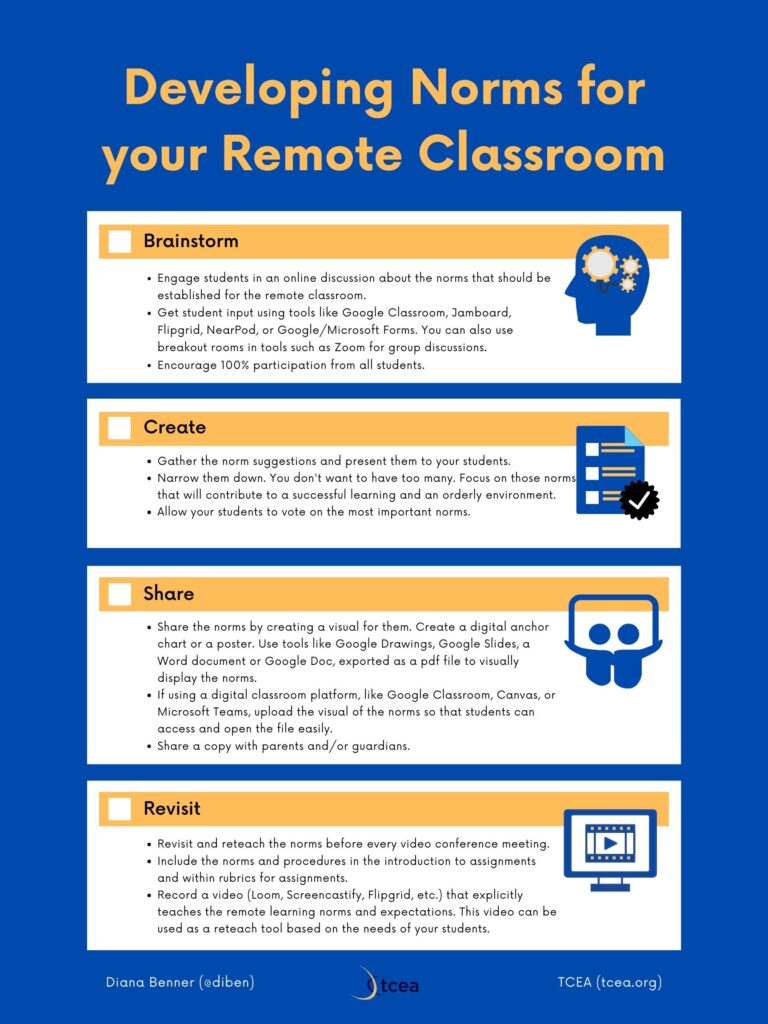Think about the activities you typically do during the first week of the school year. At the beginning of a new school year or semester, time is taken to discuss expectations that include how we should behave in class and around others. We create an understanding of what is appropriate in the classroom. These are class norms.
Many schools are starting this school year remotely. Remember, remote learning refers to a class that intends to meet face-to face in a traditional format, but is transitioned or started online due to unforeseen circumstances. In our current situation, creating norms may provide a sense of normalcy in this uncertain time. Below are some suggestions for developing and maintaining norms for your remote classroom.
Developing Norms with Students
Students are more likely to buy into the class norms if they have a hand in creating them. One way to do this is start with a list of what you consider bare essentials. Then, work together with your students to develop a set of norms.
Make sure norms are clear and specific. In addition, don’t have too many of them. Focus on those norms that will contribute to a successful, orderly learning environment. It would be to hard to remember a long list of norms. You can also get your students’ input on the consequences for breaking the norms. Check out these steps for developing norms.
In a Remote Learning Environment
In a remote learning environment, the learning might happen synchronously or asynchronously. Synchronous learning happens in real time, whereas asynchronous learning occurs without real-time interaction. Developing norms for remote learning will help foster engagement and accountability. Below are some tips to help you focus and prepare for developing remote learning norms.
Tips
- Raising your hand in class is simple, but getting the teacher’s attention in a synchronous class is more difficult. Consider how you will ask students to indicate they want to share. Some digital tools have a raise hand button.
- Use established signals to facilitate taking turns to avoid simultaneous talking. For example, mute when not speaking, thumbs up, raise hand.
- Consider when cameras should and shouldn’t be used. As the teacher, your video should be on so students can see you and read your body language. Consider giving students the option to turn their video on or off. Some students might feel uncomfortable being on camera or showing their home. If this is the case, encourage them to take advantage of digital backgrounds, if this is available in the tool you are using. You don’t want your students to feel pressured to turn on their camera.
- Think about the classroom discussions that will take place or the comments your students might make. Reinforce staying on topic. Make sure comments are clear and appropriate to the topic. Remind students not to say anything they wouldn’t say in your actual classroom. They should think before they speak.
- If you need ideas on where to get started, check out these Sample Remote Classroom Norms, Expectations, and Rules.
Be Flexible
Forming class norms early on ensures success and can shape the culture of the class in positive ways. However, be sure to be flexible and have realistic expectations. Remember, we are in a remote learning situation for a reason and even under the best circumstances, learning can be messy.
If you would like to explore remote learning more in detail, be sure to check out our Remote Learning Educator Certification online course. In addition, we have created mini-sessions that are available for you to view that focus on remote learning tips and tricks. If you have remote learning norms you would like to share, please comment below.





